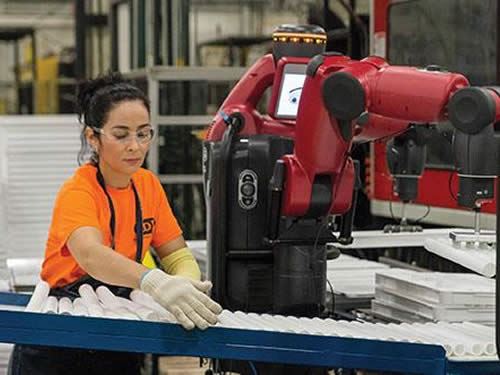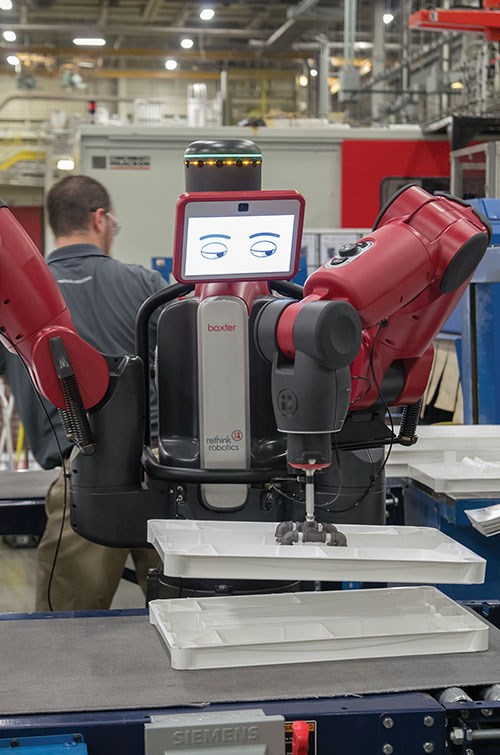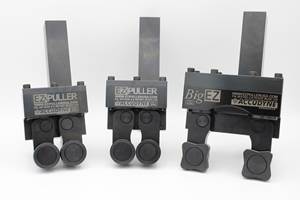No Cage Required
The next frontier for robotic automation is near human workers.
Where does robotic automation make sense? One answer is that it makes sense for high-volume production. In the case of a production part that has to be loaded into a machine the same way many thousands of times, an industrial robot offers a cost-effective way to achieve that repetitive loading without committing an operator to the work. As manufacturers continue to discover the efficiency of this choice, the use of industrial robots has grown. The promise of robotic automation in these applications is that it allows the human being to completely walk away.
However, repetitive tasks also occur at smaller volumes. What about a run of 1,000 parts, 100 parts, or just a few dozen? Could robotic automation serve manufacturers in these applications as well? For robots in manufacturing, the next frontier is likely to be those applications in which the human being does not walk away completely, but instead walks away briefly, then returns to work beside the robot, then abruptly reassigns the robot as soon as the brief and temporary task is done.
This idea is known as collaborative robotics. One example of a commercially available collaborative robot for industrial applications is “Baxter,” the interactive robot from the Boston, Massachusetts-based company Rethink Robotics.
The mere fact that Baxter has a name (and that the name is fitting enough to stick) points to what is significant about this device. Industrial robots typically are not amenable to naming. They are not like people or pets—they usually work behind guarding or in cages. But Baxter is a device that is safe to anthropomorphize, and safe to regard with comfort or humor, because the robot is physically safe for a human being to be near. As a collaborative robot, Baxter will stop its motion before it can injure any person who accidentally gets in its way, and it will actually yield to human manipulation if a person directly takes hold of the robot’s arm and moves it off of the programmed path. Rethink Robotics’s promise is that this robot does not need protective guarding or a cage, and this freedom is a big part of what makes the robot effective.
Trained Instead of Programmed
Rethink is a young company. The first commercial unit of Baxter was shipped in early 2013. The company says it now has several hundred units in customer sites, about half of which work in manufacturing applications. (Many of the others work in R&D settings.) The manufacturing users include both machine shops and plastics molders.
According to Carl Palme, a Rethink product manager who works with manufacturers to implement Baxter (see below), a significant advantage that these manufacturers see is redeployability. The robot is on wheels because it’s meant to be moved from task to task as needed. A collaborative robot is inherently user-friendly and safe, he says, but his company built on these virtues to offer a level of interactivity that makes easy redeployability possible.
For new tasks, the robot is not literally “programmed” (which would imply writing or generating code), but rather the company refers to Baxter as being “trained.” A user prepares the robot for a new job by taking hold of its arms and physically moving them through the sequence of new positions that the user wants the robot to repeat. “The robot is its own user interface,” says Eric Foellmer, Rethink’s marketing manager.
Indeed, the robot is also responsive, as the screen that provides the graphical display (and communicates basic status with a live face-like graphic during normal operation) turns automatically toward whatever robot limb the user is manually attempting to retrain.
It is because of this simple retraining that large production runs are not needed to justify the robot’s use. A repetitive operation involving just 50 workpieces could be large enough to justify wheeling the robot into place so a human can perform other work while the robot takes care of this task.
Human Value
Of course, the robot’s seeming simplicity is the product of technology that is not simple at all. Modern computer processing power is a big part of what makes Baxter possible, allowing the robot to continually monitor and reliably respond to all of the sensors around and throughout its arms that check for contact with something hard (such as a barrier in its field of motion) or something soft (such as a person). One of Rethink Robotics’s patented contributions to Baxter’s technology is the “series elastic actuator,” a device for precision motion control that allows for springy compliance if a person deliberately or unintentionally interferes with the arm.
Concern for human safety dictates the most significant constraints on what the robot can do. Per the requirements of a collaborative robot as described in ISO 10218-1: 2006, the robot is force-limited (maximum payload per arm is 5 pounds) and also deliberately speed-limited to what is characterized as a “human-like cadence.” Industrial automation applications requiring heavy parts will still require a traditional industrial robot, as will applications requiring the robot to move quickly enough to shave seconds per piece from the production time. Both of these applications continue to call for the type of robot that works within protective barriers.
By contrast, the Baxter robot makes sense in those cases where the benefit of automation is found not in the speed of the process, but in the value of the person who is set free. Throughout manufacturing, it is common to encounter jobs that—at 100 or 1,000 pieces—are far too small for committed, stationary, caged-in automation, but which therefore leave a human being bound to the machine in order to load a new piece every time the cycle is done. There are also high-volume jobs that could benefit from allowing people to work in close proximity to the manufacturing automation, the company notes. These are the jobs that make sense for a robot like Baxter, and these are the jobs that manufacturers will increasingly see as candidates for automation as collaborative robots come into more widespread use.
Article originally appeared in Modern Machine Shop's Industrial Automation supplement. Read other articles from this supplement.
Related Content
View From My Shop Video 1: A Deep Dive Into Automation with Advance CNC
Advance CNC leverages multiple forms of automation to increase its milling machines' productivity. Learn more in this episode of The View From My Shop.
Read MoreModern Bar Feeds Bring New Life to Automatic Swiss Lathes
Cam-actuated Swiss lathes are still the fastest way to process many parts. By adding modern bar feeders, this shop has dramatically improved their utilization with the ability to work unattended, even in a lights-out environment.
Read MoreZero-Adjustment Bar Pullers Simplify Turning Automation
Spring-loaded grippers and adjustable programming are enabling bar pullers to fulfill their promise to save time and money in CNC turning automation.
Read MoreLean Approach to Automated Machine Tending Delivers Quicker Paths to Success
Almost any shop can automate at least some of its production, even in low-volume, high-mix applications. The key to getting started is finding the simplest solutions that fit your requirements. It helps to work with an automation partner that understands your needs.
Read MoreRead Next
The Cut Scene: The Finer Details of Large-Format Machining
Small details and features can have an outsized impact on large parts, such as Barbco’s collapsible utility drill head.
Read More3 Mistakes That Cause CNC Programs to Fail
Despite enhancements to manufacturing technology, there are still issues today that can cause programs to fail. These failures can cause lost time, scrapped parts, damaged machines and even injured operators.
Read More.png;maxWidth=970;quality=90)
.jpg;width=70;height=70;mode=crop)












.png;maxWidth=300;quality=90)




















